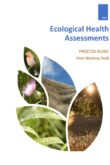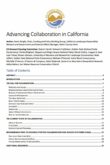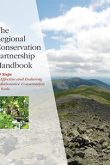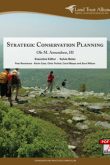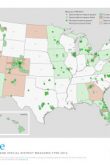Resources Library
A repository of resources and knowledge on the practice of landscape conservation.
To search the Library, use the dropdown menu to select a category and then click the green “Explore” button. Alternatively, the library can be searched directly by clicking over to the “Search” tab and entering a keyword.
Explore the library and return regularly to stay up-to-date on the newest resources and knowledge informing the practice of landscape conservation—our hope is that this Library is a valuable knowledge base that empowers you and your fellow practitioners to accelerate your work, build capacity within the field, and achieve on-the-ground conservation success.
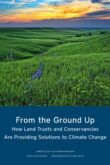
From the Ground Up: How Land Trusts and Conservancies Are Providing Solutions to Climate Change
This report offers numerous case examples of successful initiatives along with the guidance for stakeholders in the private and public sectors looking to boost the potential of civic organizations to implement natural climate solutions. As communities worldwide make protecting the climate a priority, land trusts and conservancies of all sizes and capacities are seeking greater clarity in how to address climate change through land conservation and stewardship. Policy makers and decision makers are considering how to address climate-related impacts in communities, states, and regions. Funders and donors are seeking to invest in projects and initiatives which offer durable, lasting solutions for reducing carbon emissions and improving climate resilience.
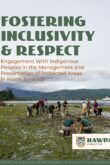
Fostering Inclusivity And Respect: Engagement With Indigenous Peoples In The Management And Presentation Of Protected Areas In North America
This report includes a collection of stories that reveal a diversity of approaches to collaboration among indigenous organizations and communities and federal managers geared to different ecological and social contexts, timelines, and cultural considerations. While not exhaustive, they provide examples that land management practitioners and community leaders can consider and learn from as they attempt to foster increasingly productive relationships in their own work.
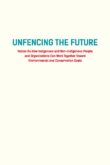
Unfencing The Future: Voices On How Indigenous And Non-Indigenous People And Organizations Can Work Together Toward Environmental And Conservation Goals
The goal of this project is to inform and support non-Indigenous conservation groups and conservation and environmental funders’ staff and boards working with Indigenous communities with a geographic focus of the western contiguous United States, Alaska, and western Canada. This document follows a path created by others and builds on contributions to the body of growing resources on collaboration and, in Cherokee, called “gadugi,” (helping each other). Read more for key themes and points that emerged for environmental and conservation organizations.
Placing Fairness at the Root: Three Case Studies in Conservation Finance Justice
Conservation practitioners are evolving the mainstream practice to include consideration of social equity. In forests, urban districts, and foundation boardrooms, they’re infusing the history of past wrongs into forward-looking strategies. The case studies here cap a semester of research and invite practitioners to a new phase of impact.
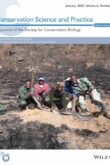
Can a large-landscape conservation vision contribute to achieving biodiversity targets?
Founded in 1993, the Yellowstone to Yukon (Y2Y) vision was one of the earliest large-landscape conservation visions. Despite growing recognition of large-landscape conservation strategies, there have been few tests to date of conservation gains achieved through such approaches. In this paper, counterfactual comparison provides valuable evidence that large-landscape conservation strategies such as Y2Y can enhance protected area growth and other conservation metrics. It concludes that large-landscape conservation strategies may be a useful model for achieving global large-landscape conservation and biodiversity conservation targets.
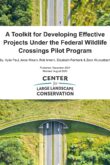
A Toolkit for Developing Effective Projects Under the Federal Wildlife Crossings Pilot Program
Published: December 2021 Revised: August 2023
Kylie Paul, Anna Wearn, Rob Ament, Elizabeth Fairbank & Zack Wurtzebach
DetailsThis document highlights best practices, examples, and resources for designing effective wildlife crossing projects in accordance with the criteria for the federal “Wildlife Crossings Pilot Program.” The Infrastructure Investment and Jobs Act (H.R. 3684), which became law in November 2021 (Public Law 117-58, also known as the “Bipartisan Infrastructure Law”), provided new federal funding for projects and research to reduce wildlife-vehicle collisions (WVCs) and improve habitat connectivity. One of the key provisions is the establishment of a new, $350-million (total) Wildlife Crossings Pilot Program (WCPP) for fiscal years 2022 through 2026.
Explore which public lands in the U.S. are best for mitigating climate change and
protecting threatened species and habitats! Identify new opportunities for bold action to meet U.S.
climate and conservation goals, including protecting 30% of the nation’s lands by 2030!
The Climate Atlas offers one of the clearest assessm
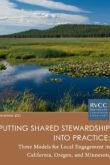
Putting Shared Stewardship Into Practice: Three Models For Local Engagement In California, Oregon, And Minnesota
In 2018, the U.S. Forest Service (the Forest Service) introduced its Shared Stewardship Investment Strategy, a vision to address large-scale, cross-jurisdictional land management concerns through a renewed emphasis on partnerships. With this strategy, the agency committed to working directly with states on issues of mutual concern. Key components of cooperation included identification of priority areas for restoration, leveraging the best available decision-support tools, and capitalizing on all available resources and authorities.
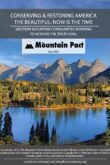
Conserving & Restoring America The Beautiful: Now Is The Time July 2021 Western Mountain Communities Working To Achieve The 30×30 Goal
In this report, The Mountain Pact provides some background on the America the Beautiful initiative and why it is important to Western mountain communities. It also highlights examples from local elected officials in the Mountain Pact Network of how Western mountain communities have and are helping to achieve the goal of conserving and restoring 30% of our lands and waters by 2030 through locally-led collaborative projects. These examples include the adoption of resolutions, on-the-ground conservation work, and policy recommendations.
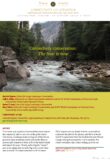
Connectivity conservation: The time is now
The theory and practice of connectivity conservation have matured, and we are now at the point where intentional, landscape-scale ecological networks are poised to play an indispensable role in the drive to protect and conserve at least 30% of the Earth’s lands and waters by 2030. Clearly, achieving the “30×30” goal is an urgent matter as a big step toward what nature needs. The stark conclusions of the latest IPCC report leave no doubt that the 2020s will be a decisive decade for the planet, and there is broad scientific agreement that the biodiversity and climate change emergencies must be met in tandem.
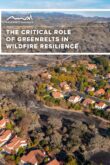
The Critical Role of Greenbelts in Wildfire Resilience
This article identifies types of greenbelts, the role the greenbelts play, and policy recommendations to achieve greater climate resilience by elevating greenbelts. The Bay Area is at a tipping point in its relationship to wildfire. Decision makers, planners, and advocates must work together on urgent solutions that will keep communities safe from wildfires while also addressing the acute housing crisis. There is huge potential for the Bay Area, and other places across the Western US, to accelerate greenbelts as critical land-use tools to bolster wildfire resilience.
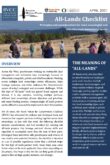
All-Lands Checklist Principles and considerations for more meaningful and effective cross-boundary projects
This checklist presents considerations and best practices for carrying out all-lands projects that leverage partners’ diverse skills and capacities to accomplish more than the sum of their parts. Across the West, practitioners working on sustainable land management and restoration have increasingly focused on efforts that cross public, private, and tribal boundaries. Working across multiple land ownerships creates efficiencies, helps leverage resources, and better addresses the interconnected nature of today’s ecological and economic challenges. While this type of “all-lands” work has gained broad support and interest, it is also complex, involving multiple partners, different land ownerships, diverse objectives and priorities, and many funding sources.

Putting collaborative leadership into practice: The role of peer learning
This article explores peer learning and its role in learning, demonstrating, and building collaborative leadership. Learning and exchange among peers (“peer learning”) is an important process shaping and enabling landscape conservation and stewardship. As a practice that connects practitioners working at the landscape scale within and across regions, peer learning builds and strengthens the relationships at the core of the collaboration that are central to meeting shared goals and needs.
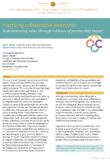
Practicing collaborative leadership: Demonstrating value through evidence of partnership impact
In this article the Partnerships Impact Model is introduced as a promising impact assessment framework. As the 21st century’s dynamic natural and social landscapes include increased wildfire intensity, unpredictable weather patterns, and demands for equity and justice. The scale of these challenges requires new and creative approaches to land protection and stewardship. However, there is a shortage of research-based frameworks to evaluate the impact of landscape stewardship partnerships practicing collaborative leadership.
Together, we’ll go further: The opportunity of collaborative leadership
This paper, one of three in a series, explores what makes collaborative leadership work, and why it is so critical to meet our landscape stewardship needs. Tending to long-term landscape health and resilience is a highly complex enterprise. To address this complexity, we must imagine and facilitate a community-based response that is just as complex, inclusive, interdependent, informed, deliberative, and adaptive as the challenges we face.
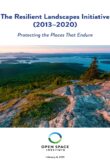
The Resilient Landscapes Initiative (2013–2020): Protecting the Places That Endure
This report provides an overview and captures insights from the Resilient Landscapes Initiative’s history of translating groundbreaking climate science and new approaches to land protection in the face of climate change. By its completion in 2020, the Resilient Landscapes Initiative had awarded $11 million to support 59 projects that protected 50,000 acres. Beyond the acreage data, the Initiative promoted a shift in conservation outcomes and planning — from a focus on natural communities and species to the protection of enduring features on the landscape, i.e., those places most likely to harbor plants and animals in a warming world.
This research is a synthesis that distills out insights into research into the behaviors that influence successful collaboration. As we continue to face complex and difficult-to-solve problems such as climate change, social injustice, and a global pandemic, the need for collaboration is more pressing than ever. Multi-stakeholder partnerships (MSPs) are touted as promising mechanisms to tackle these challenges; however, despite their promise, not all partnerships are successful in their collaborative efforts. The purpose of the research presented here is to better understand collaboration in the context of MSPs.
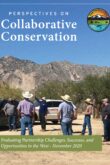
Perspectives on Collaborative Conservation: Evaluating Partnership Challenges, Successes, and Opportunities in the West
The goal of this report was to determine what partnerships are doing, how they measure and share the story of their progress,and what lessons and insights they can offer other collaborative efforts to advance natural resource conservation in the West. According to the Western CollaborativeConservation Network, over 450 known collaborative groups are incorporating diverse perspectives across jurisdictions to build the bridges needed to overcome the natural resource challenges of the West. How do participants know if collaboration is worth their time and resources? What tools can help them evaluate the effectiveness of their partnerships? And how can answering these questions help collaboratives achieve their goals?

Weaving the Strands Together: Case studies in inclusive and equitable landscape conservation
The purpose of this report is to illustrate how values of diversity, equity, and inclusion have strengthened landscape conservation projects across the United States. Additional resources for the landscape conservation community are provided to assist others in the process of integrating diversity, inclusion, and equity principles into their work. This report is a joint project of the Network for Landscape Conservation, the Salazar Center for North American Conservation, and the Center for Large Landscape Conservation, in cooperation with the four initiatives profiled herein.
The Network for Landscape Conservation and the Salazar Center for North American Conservation have teamed up to showcase four case studies that explore how principles of equity and inclusion can operate within and improve landscape conservation initiatives. The Bears Ears National Monument case study captures Indigenous connection to a culturally and spiritually invaluable landscape in the western United States. The Klamath River watershed in the Pacific Northwest is home to what used to be the Pacific Coast’s third-largest salmon run, and the removal of four dams on the river lies at the heart of reconnecting tribes to their cultural and spiritual heritage. The Kankakee Sands in Northeastern Illinois is home to the world’s largest remaining stand of black oak savanna and Black families who have stewarded this fragmented landscape for generations. Lastly, the Baltimore Wilderness case study tells a story of how urban conservation unfolds within a diverse city
Natural Highways and Neighborhoods: Conserving a Network of Climate-Resilient Lands
The Nature Conservancy released climate resilience data that covers the entire continental United States, offering a fine-resolution assessment of our landscapes’ climate resilience—its capacity to maintain species diversity and ecological function as the climate changes. A decade in the making, this data is grounded in the understanding that biodiversity conservation must be forward-looking due to climate change: conservation planning based on current biodiversity patterns will increasingly become less effective at sustaining species and natural processes over the long term. The Nature Conservancy has utilized this data to identify a “roadmap” of Resilient and Connected Landscape across the United States, identifying sites that cover a third of the continental United States and that will withstand climate impacts and keep nature safe in the face of climate change.
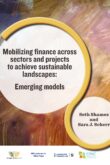
Mobilizing finance across sectors and projects to achieve sustainable landscapes: Emerging models
August 2020
Seth Shames Director, Finance and Policy, EcoAgriculture Partners Sara J. Scherr President and CEO, EcoAgriculture Partners
DetailsThis paper reviews the investment models and innovations emerging from the field of integrated landscape investing, which is developing quickly to meet the financing needs of landscape projects as well as the demand from investors for bankable landscape projects. Both small and large financial actors are looking for business models that allow them to contribute to social and ecological outcomes while also generating financial returns. These efforts are being supported by emerging policy frameworks at national and international levels such as the Green Deal for Nature and the UN Decade of Landscape Restoration.
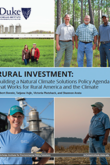
Rural Investment: Building a Natural Climate Solutions Policy Agenda that Works for Rural America and the Climate
This report outlines a menu of policy ideas capable of both garnering the necessary support from rural America and helping the U.S. reach its climate goals through natural climate solutions. Under any reasonable scenario, meeting aggressive climate goals will require farmers, ranchers, forest owners and public land management agencies to prioritize climate mitigation across hundreds of millions of acres. Success will require new federal policies and, importantly, accelerated and substantial increases in public and private investment in land management practices that sequester carbon and reduce GHGs.

Guidelines for conserving connectivity through ecological networks and corridors
These Guidelines are based on the best available science and practice for maintaining, enhancing and restoring ecological connectivity among and between protected areas, other effective areas based conservation measures (OECMs) and other intact ecosystems. For the first time, this publication introduces a common definition and recommends formal recognition of ecological corridors to serve as critical building blocks of ecological networks in conjunction with protected areas and OECMs. Furthermore, these Guidelines also include 25 case studies that demonstrate current approaches to conserving ecological connectivity and ecological networks for different ecosystems and species, and at different spatial and temporal scales.
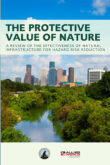
The Protective Value of Nature
This report summarizes the latest science on the effectiveness of natural infrastructure in lowering the risks to communities from weather- and climate-related hazards. Highlighted throughout the report, evidence suggests that both natural and nature-based approaches for hazard mitigation can be equally or more effective than conventional structural approaches, and they are often more cost-effective.
SHARED STEWARDSHIP: RECOMMENDATIONS for PARTNERING WITH COMMUNITY-BASED AND COLLABORATIVE GROUPS
The nation’s forests face urgent threats, including uncharacteristic wildfire, insects and disease, drought, and climate change. The complexity, scale, and crossboundary nature of these threats mean that no single agency has the capacity or resources to tackle them alone. To address these concerns, RVCC has developed recommendations for state agencies to partner with community-based and collaborative partners. The recommendations are based on themes from two in-person workshops and one-on-one conversations with early adopters.
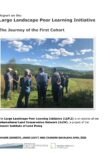
Large Landscape Peer Learning Initiative: the Journey of the First Cohort
Large Landscape Peer Learning Initiative released a new report summarizing two years of peer learning exchange amongst a small cohort of landscape conservation leaders from across the globe. In the fall of 2018, four teams of participants gathered in Sonoma County, California to kick-off a shared journey – a shared journey, that is, in both the literal and figurative meanings of the phrase. Teams visited sections of the territories of each of four participating large landscape conservation initiatives. At the conclusion of these visits and interactions in California, Chile and Vermont, the group presented Case Statements of their respective histories and current situations, challenges and proposed strategies going forward, in both written and oral form, to a group of conservation finance, organization, policy and stewardship experts assembled in Woodstock, Vermont.
One Tam partnership released a new Ecological Health Assessment Guide, a tool for practitioners interested in developing and monitoring regional ecological health indicators in their landscapes. Fundamental to understanding how to manage and steward the natural world, raise awareness, or inspire action is being able to describe how your resources are faring and what needs intervention, and to do so in a credible and compelling way. One way that natural resource-based agencies, organizations, or partnerships may choose to do this is through an assessment of the state of their resources. While these “ecological health assessments” are often initially developed to create a baseline against which future change can be measured, they can also focus management priorities, educate the public, generate action, and/or increase financial or political support.
Toward Holistic Landscape Conservation in the 21st Century
This paper makes a case for holistic landscape conservation efforts, discusses proposed elements for holistic landscape collaborations that meet both ecological and social goals, and examines the consequences of their implementation in multiple settings. Here in the United States, observers often see conflict between efforts to conserve nature in the face of massive loss of biological diversity versus efforts to provide all our people with suitable housing and access to adequate food, clean air and water, and outdoor recreation. The emergence of landscape conservation through robust human community collaboration that provides for the non-human interests of wildlife and nature is seen as a necessary approach to meet these daunting challenges. Across the country there are many examples of conservation success through landscape collaboration, but the concept is hindered by incomplete application and a lack of suitable measures of program outcomes.
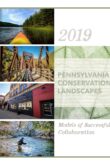
Conservation Landscapes: Models of Successful Collaboration
For more than fifteen years, place-based landscape partnerships in Pennsylvania have been driving strategic investments and actions around sustainability, conservation, community revitalization, and recreation projects. Spearheaded by the Commonwealth’s Department of Conservation and Natural Resources (DCNR), this Conservation Landscapes program is an innovative example of state leadership in the realm of collaborative landscape conservation. In 2019, DCNR undertook an independent evaluation of the program to better understand the impact of the program and best practices and successes that have emerged—and to identify recommendations for continuing to improve and sustain the program. While focused on the context of Pennsylvania, the results, best practices, recommendations, and insights of the report are broadly applicable across geographies.
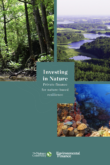
Investing in Nature: Private Finance for Nature-based Resilience
This report aims to capture qualitative measurement of the positive momentum being built with market-based solutions to protect and improve natural capital. The points of view collected from investors, deal makers, intermediaries and governments reveal what is working well, and in some cases, not so well. What is clear from this report, however, is that investments in nature are seen as both a necessity and an opportunity. Whether an investor’s motivation is profit, resilience, compliance or mission, natural capital will be increasingly factored into investment decisions.
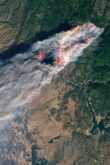
Five Things We Can Do in the Next 24 Months to Mobilize Major Investments in Ecosystem Restoration and Climate Resilience
In the next decade, the world will probably see the biggest ecological restoration effort in history. We have seen a recent wave of major commitments to large-scale landscape restoration. In pursuit of natural climate solutions and the Sustainable Development Goals, nearly $1.5 billion was pledged by donors in the fall of 2018 in the wake of the Global Climate Action Summit. In March, the United Nations General Assembly declared the 2021-2030 period the UN Decade on Ecological Restoration. What is still missing are the underpinnings of a financial strategy: How do we finance and execute restoration and sustainable land use at the necessary scale? How do we coordinate actions across many nations, sectors, and value chains to ensure that we’re meeting our goals?
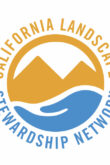
Advancing Collaboration in California
January 2020
Author: Kevin Wright, Chair, Funding and Policy Working Group, California Landscape Stewardship Network and Government and External Affairs Manager, Marin County Parks
DetailsThis paper reinforces the a primary purpose of the California Landscape Stewardship Network (CA Network) – to support the field of existing practice that is already doing great work to advance collaborative stewardship. It is a celebration of the many efforts that California has already undertaken to advance collaborative landscape stewardship. Innovative and forward-looking state efforts have inspired the CA Network to look ahead in partnership with the state, and explore ways to work together to advance collaborative landscape scale approaches even further.
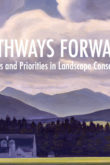
Pathways Forward: Progress and Priorities in Landscape Conservation
Pathways Forward captures the insights of 200 conservation leaders from the U.S., Canada, and Mexico who convened for two days in November 2017 at the National Forum on Landscape Conservation to strategize on the rapidly growing practice of collaborative conservation at the landscape scale. The report assesses the state of the field, showcases many innovative examples, and recommends ways to further advance this transformative conservation approach—together and in our own landscapes. The report is comprised of five chapters that explore various elements of landscape conservation: collaboration; communication and engagement; science and planning; finance and funding; and policy. Each chapter concludes with a series of five-year Benchmarks, that serve as forward-looking and aspiration targets for the landscape conservation field.

Generating, Scaling Up, and Sustaining Partnership Impact: One Tam’s First Four Years
This report emerged out of an independent and in-depth assessment over the course of four years, coinciding with the launch and growth of the One Tam initiative in the Mount Tamalpais landscape of California. The case study is instructive in and of itself in understanding the experience of launching and growing a collaborative landscape conservation partnership; most powerfully though, the report builds beyond this case study to frame an overarching “Partnership Impact Model”–a framework for understanding, articulating, and optimizing the impact and value of collaboration.
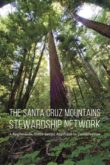
Santa Cruz Mountains Stewardship Network: A Regionwide, Cross-Sector Approach to Conservation
This publication presents a case study of the first two years of an emergent landscape conservation initiative the Santa Cruz Mountains Stewardship Network – the obstacles that were encountered and overcome, the lessons learned, and the challenges ahead. Interwoven throughout the case study are frameworks, tools, and insights that are broadly applicable across all contexts.
Rather than forming the network around a clearly-defined purpose and a set of measurable objectives, the the Santa Cruz Mountains Stewardship Network followed a network formation process from 2014 to 2016 that allowed outcomes to emerge from a process that emphasized cultivating strong trust-based relationships between participants, facilitating the right conversations, and implementing necessary leadership, organizational structures, and decision-making processes as the network evolves. The result has been the emergence of The Santa Cruz Mountains Stewardship Network as a collaboration of nineteen federal, state, and county agencies, land trusts, nonprofits, research institutes, a Native American tribal band, and a timber company, that works to improve land stewardship in the Santa Cruz Mountains region south of San Francisco.
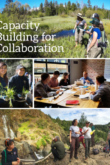
Capacity Building for Collaboration: A Case Study on Building and Sustaining Landscape-Scale Stewardship Networks in the 21st Century
Commissioned by the California Landscape Stewardship Network, this case study offers a closer examination of the trends, innovations, practices, and intricacies of funding and sustaining collaboration at scale. Specifically, this case study outlines capacity building challenges and trends facing landscape-scale stewardship networks; shares advice and experiences from a wide range of experts and stakeholders in the field; and highlights mindsets and strategies that have been successful in building capacity for collaboration.
Turf, Trust, Co-Creation and Collective Impact
Authentic community change moves at the speed of trust. And yet, we spend so little time and focus on intentionally building trust amongst partners. This paper explores the intricacies of trust, how to build it and what to do when trust is broken. It includes stories, research, and a plethora of helpful tips to equip you and your colleagues to focus on building trust with each other and with your partners.
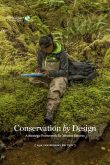
Conservation by Design: A strategic Framework for Mission Success
This report lays out the adaptive management cycle that The Nature Conservancy has adopted to integrate analyses of where to work and how to accomplish its work. The report highlights the interdependence of social and natural systems, and aims to create virtuous cycles between people and nature within those integrated systems. Presented as a guide to practitioners, the principles of TNC’s Conservation by Design approach and uses case studies to bring these principles to life.
Also see TNC’s Conservation by Design web-platform
The Conservation Finance Toolkit is a resource explaining tools and techniques available to conservation-finance practitioners. Tools covered vary from the simple to the complex. Each writeup contains an example of the technique in practice.
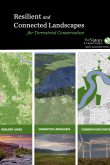
Resilient and Connected Landscapes for Terrestrial Conservation
2016
Authors: Mark G. Anderson, Analie Barnett, Melissa Clark, Arlene Olivero Sheldon, John Prince and Barbara Vickery
DetailsThis report by The Nature Conservancy brings together resilience, permeability, and diversity to develop a connected network of sites that both represents the full suite of geophysical settings and has the connections and networks necessary to support the continued rearrangement of species in response to change.
Check out TNC’s Resilient and Connected Landscapes web-platform.
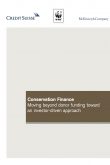
Conservation Finance: Moving beyond donor funding toward an investor-driven approach
2014
Authors: Fabian Huwyler, Jürg Käppeli, Katharina Serafimova, Eric Swanson, and John Tobin
DetailsTo preserve the health of natural ecosystems, a significantly larger amount of capital investment is required than the sums currently being allocated to conservation. Private sector investment is needed, not to replace but to supplement traditional sources of conservation capital such as public funding or philanthropy, which have been impacted by the global economic downturn. Against this backdrop, WWF and Credit Suisse have joined forces in the area of conservation finance to iden- tify the conditions needed to attract and redirect private capital toward conservation.
This report shows that there are many unexploited private sector investment opportunities to increase conservation finance and deliver maximum conservation impacts while, at the same time, generating returns for investors. In order to develop appropriate financing structures and ensure that private sector conservation finance results in measurable conservation outcomes, financial institutions and non-governmental organizations must experiment and define their respective roles and approaches. If both sides concentrate on their main areas of expertise – with banks focusing on the alignment of capital resources, risks, and maturities, while NGOs identify measures to protect the natural environment – we can create a new opportunity for collaboration that will help to preserve natural capital for future generations. Provided it delivers measurable results, investor-driven conservation finance can create powerful incentives for truly sustainable development.
This white paper from the California Landscape Stewardship Network celebrates the many efforts the state has already undertaken to advance collaborative landscape stewardship, and explore paths forward for working together to advance collaborative landscape scale approaches even further. The white paper summarizes leading state plans and policies that call for regional collaboration, recognizes current challenges and successes in the field, takes a look at existing state funding sources to support this work, and ends with recommendations for how to advance this field of practice.
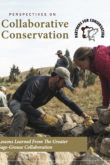
Perspectives on Collaborative Conservation: Lessons Learned from the Greater Sage Grouse Collaboration
Collaboration and partnerships between 2010 and 2015 have been recognized as a key reason the greater sage grouse was kept off the federal endangered species list. Partners for Conservation undertook an explored this unprecedented collaboration in an effort to draw lessons from the successes and challenges of the process. Based on interviews with more than 40 individuals that were actively involved in the sage grouse collaboration efforts, this report presents a synopsis of the various responses and identifies primary themes that emerged across perspectives. By identifying what worked well–and where the greatest challenges emerged–the report aims to distill lessons that can be broadly applicable across contexts in helping guide collaborative conservation on future natural resources challenges.
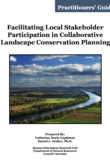
Facilitating Local Stakeholder Participation in Collaborative Landscape Conservation Planning: A Practitioners’ Guide
This document provides guidance on integrating local stakeholder participation and social data into collaborative landscape conservation (CLC) planning. This Guide draws on empirical analysis of current collaborative landscape conservation initiatives to highlight how local stakeholders and social data have been used in a range of landscape conservation planning efforts. We share insights regarding local stakeholders’ preferences for participation in collaborative landscape conservation planning and some of the undesirable impacts resulting from not considering social data or local stakeholders’ input during these planning efforts. We offer a process model indicating when and how local stakeholder participation and social data might be usefully integrated during collaborative landscape conservation planning. We close the Guide by examining resources that those responsible for developing collaborative landscape conservation planning products might draw on to find existing social data and how they might collect new data from local stakeholders. We believe guidance provided in this document can help foster effective landscape conservation planning by increasing local stakeholders’ investment in collaborative landscape conservation planning processes and products and their sense of ownership over conservation decisions and outcomes.
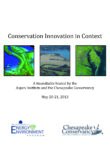
Conservation Innovation in Context
In May 2013, the Aspen Institute and the Chesapeake Conservancy partnered to host a Conservation Innovation Roundtable to discuss challenges currently facing conservation organizations and promising technology and techniques that could help bridge some of these gaps. Over the course of two days, thirty-five experts in the fields of conservation targeting, remote sensing, communications and conservation finance focused discussion on four main topic areas: 1) Conservation in Context – From Global to Local, 2) Innovative Tools for Public Engagement in Conservation, 3) New Financing Models for Conservation, and 4) Technology – Remote and On-the-Ground Sensing. The discussion resulted in five key observations: (1) There is a tremendous amount of potential for conservation innovation to improve the effectiveness and efficiency of local, state and federal conservation programs as well as non-profit organizations; (2) Large-landscape initiatives require local partners; (3) Public demand and support is critical to the success of conservation initiatives; (4) To be effective ecosystem markets and regulations must accurately prove they have improved over-all ecosystem health; and (5) Ecosystem markets that accurately reflect the impact of conservation and restoration will lead to an influx of private capital. This report details these five observations and more from the roundtable discussions.
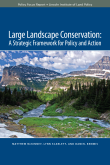
Large Landscape Conservation: A Strategic Framework for Policy and Action
In response to increasing activity at the landscape scale, leaders from the public, private, and nongovernmental sectors participated in two national policy dialogues and many other informal discussions in 2009. This report seeks to bridge the gap between theory and practice by combining research findings and case studies with the insights emerging from these policy dialogues to synthesize what we know about landscape conservation and to identify the most important needs as we move forward.
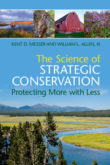
The Science of Strategic Conservation: Protecting More with Less
Billions have been spent on land conservation but too little attention had been paid to how cost-effective these investments have been. With budgets increasingly constrained, conservationists must learn to fully harness their funds to protect critical resources. Messer and Allen are pioneers in making conservation selection more successful, cost-effective, scientific, and transparent. This book introduces powerful mathematical tools available for project selection, using real-life examples and a practical step-by-step approach. Readers can readily apply these methods to their own work, accomplishing more with less by combining the individual benefits of structured decision-making, mathematical programming, and an understanding of market forces and human behavior. The authors highlight tools from conservation science, mathematics, land use planning and behavioral economics, showing how they can be combined to help protect key environmental resources. This is an invaluable volume for all students, professionals and stakeholders associated with conservation programs.
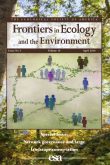
Network Governance and Large Landscape Conservation
This Special Issue of Frontiers in Ecology and the Environment explores the application of network governance to large landscape conservation. The following article comprise the issue:
- Forging new models of natural resource governance
- Connecting people and places: the emerging role of network governance in large landscape conservation
- Understanding leadership in a world of shared problems: advancing network governance in large landscape conservation
- Sustaining the useful life of network governance: life cycles and developmental challenges
- Networks and landscapes: a framework for setting goals and evaluating performance at the large landscape scale
- Navigating governance networks for community-based conservation
- Network governance for large-scale natural resource conservation and the challenge of capture
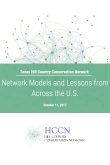
Network Models and Lessons from Across the U.S.
Over the past few decades, networks have emerged as a powerful and widely-used approach for advancing progress in large landscape conservation and in numerous other environmental and social issue domains. This report summarizes findings from research on networks, exploring questions such as: What is a network? Why use networks? What types of networks are being used to support conservation? And what lessons can be drawn from the experiences from other networks? The findings and information in this report are drawn from a literature review of publications, articles, and websites on networks; interviews with more than 20 network experts and practitioners from across the U.S.; and review of materials related to several examples of networks focused on conservation or other environmental issues. This report includes a brief synthesis of findings related to the key questions outlined above, as well as brief profiles of six networks in the U.S. that are focused on conservation or other environmental issues.
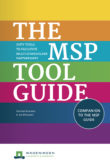
The MSP Tool Guide: Sixty Tools to Facilitate Multi-Stakeholder Partnerships
The MSP Tool Guide is a companion to the MSP Guide: How to Design and Facilitate Multi-Stakeholder Partnerships. This Tool Guide offers 60 process tools serving different purposes in the facilitation of multi-stakeholder partnerships.
The tools in the guide are grouped by six purposes – connection, issue exploration and shared language, divergence, co-creation, convergence, and commitment – inspired by the work of Sam Kaner (2014) and the Rockefeller Foundation’s GATHER guide. These purposes often coincide with a particular stage of a multi-stakeholder partnership: connecting, for example, will usually happen at the start.
The Tool Guide explores in-depth 60 participatory tools for analysis, planning, and decision-making that are aimed at empowering practitioners to more effectively facilitate multi-stakeholder partnerships.
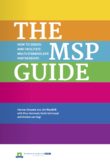
The MSP Guide: How to Design and Facilitate Multi-Stakeholder Partnerships
2015
Authors: Herman Brouwer and Jim Woodhill, with Mini Hemmati, Karen Verhoosel, and Simone van Vugt
DetailsIn recent years, multi-stakeholder partnerships (MSPs) have become popular for tackling the complex challenges of sustainable development. This guide provides a practical framework for the design and facilitation of these collaborative processes that work across the boundaries of business, government, civil society and science.
The guide links the underlying rationale for multi-stakeholder partnerships, with a clear four phase process model, a set of seven core principles, key ideas for facilitation and 60 participatory tools for analysis, planning and decision making.
The guide has been written for those directly involved in MSPs – as a stakeholder, leader, action researcher, facilitator or funder – to provide both the conceptual foundations and practical tools that underpin successful partnerships. What’s inside draws on the direct experience of staff from the Centre of Development Innovation (CDI), at Wageningen University & Research, in supporting MSP processes in many countries around the world. The guide also compiles the ideas and materials behind CDI’s annual three week international course on facilitating MSPs.
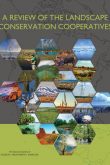
A Review of the Landscape Conservation Cooperatives
This review evaluates the purpose, goals, and scientific merits of the Landscape Conservation Cooperatives program within the context of similar programs, and whether the program has resulted in measurable improvements in the health of fish, wildlife, and their habitats.
The RCP Handbook is a resource aimed at driving collaborative conservation in New England, New York, and beyond. The RCP Handbook captures the experiences of RCPs to date and outlines 10 steps identified as important to RCP success. Building upon the knowledge gained from partnerships that are part of the RCP Network, the Handbook is organized around the three fundamental stages of RCP growth (Emerging, Maturing, and Conserving).
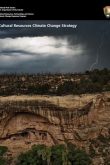
Cultural Resources Climate Change Strategy, National Park Service
2016
Authors: Marcy Rockman, Marissa Morgan, Sonya Ziaja, George Hambrecht, and Alison Meadow.
DetailsThe Cultural Resources Climate Change Strategy sets out a vision and broad approach for managing impacts to and learning from cultural resources under modern climate change.
Cultural resources are our record of the human experience. Collectively, these archeological sites, cultural landscapes, ethnographic resources, museum collections, and historic buildings and structures connect one generation to the next. The National Park Service is charged with conserving cultural resources so that they may be enjoyed by future generations. Climate change is adding challenges to this role, and will continue to affect cultural resources in diverse ways. At the same time, through the tangible and intangible qualities they hold, cultural resources are also part of the solution to climate change.

Expanding Horizons: Highlights from the National Workshop on Large Landscape Conservation
This report summarizes the National Workshop on Large Landscape Conservation — the first major conference on large landscape conservation in North America. Over 650 conservation professionals came together to celebrate progress and share ideas on large-scale collaborations. The report stresses a multi-disciplinary, networked approach to finding solutions that benefit human, wildlife, cultural and ecological health.
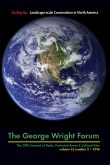
Scaling Up: Landscape-scale Conservation in North America
This special issue of the George Wright Forum examines past and current practice in landscape-scale conservation; a common thread is that the National Park Service (NPS) has a role in all of our examples. Articles in the issue stress the importance of working at scale and taking an expansive, landscape view. The Landscape Conservation Cooperatives are highlighted, as is the national heritage areas program. Case studies are offered on emerging landscape conservation initiatives along the Appalachian Trail and in the Chesapeake watershed, and the Network for Landscape Conservation is highlighted as well.
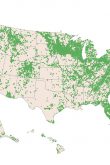
Conservation Almanac: Tracking Investments in Protected Lands
The Conservation Almanac is a powerful online tool for analyzing and mapping federal, state, and local funding for land conservation. Launched in 2006 by The Trust for Public Land, conservationalmanac.org has become the go-to website for planners, journalists, conservationists, and researchers seeking to understand land conservation nationwide and in defined
regions.
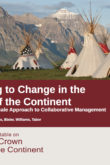
Adapting to Change in the Crown of the Continent: An Ecosystem Scale Approach to Collaborative Management
2015
Authors: Melly Reuling, Shawn Johnson, Sue Higgins, Patrick Bixler, Sam Williams, and Gary Tabor
DetailsThis report is a primer exploring the work of the Roundtable on the Crown of the Continent. As a case study of a collaborative initiative working together in a landscape experiencing a rapid rate of change, this report draws upon the Roundtable’s stories and lessons learned in the hope of providing other diverse communities and other initiatives with hope, inspiration, and insight as they seek a path forward in a world struggling with immense change.
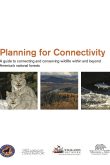
Planning for Connectivity: A guide to connecting and conserving wildlife within and beyond America’s national forests
Planning for Connectivity is a product of the Center for Large Landscape Conservation, Defenders of Wildlife, Wildlands Network and Yellowstone to Yukon Conservation Initiative. This guide focuses on requirements established under the National Forest System land management planning rule to manage for ecological connectivity on national forest lands and facilitate connectivity on planning acrosss land ownerships. The purpose of the guide and its parent publication, Planning for Diversity, is to help people inside and outside of the Forest Service who are working on forest plan revisions navigate these complex diversity and connectivity requirements.
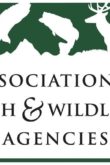
Landscape Conservation Collaboration: A White Paper
In 2018, a working group of the Association of Fish and Wildlife Agencies, which represents North America’s state fish and wildlife agencies, developed a white paper on landscape conservation. The white paper identifies key challenges and lessons learned for landscape conservation, and emerged from the AFWA working group that was convened to examine existing landscape partnerships and their governance structures, commonalities of success, approaches, partner roles and other attributes. Beginning first at a regional level, the white paper reviews efforts in the Northeast, Southeast, Midwest, and Western regions to understand key drivers, challenges, and successes for collaboration in each region. A broader discussion across regional contexts follows, and the white paper concludes by identifying opportunities and next steps.

Adapting to Climate Change: Guidance for protected area managers and planners
The world’s climate is changing rapidly and protected areas are an increasingly important component of national and international climate change adaptation strategies. These guidelines articulate essential elements for adaptation planning and implementation, and it describes additional resources that site managers can use right away.
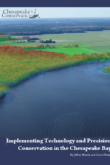
Implementing Technology and Precision Conservation in the Chesapeake Bay
In 2012, Chesapeake Conservancy, with the support of the Digital Energy and Sustainability Solutions Campaign (DESSC), explored the role that technology could play in expanding the application of precision conservation; or getting the right practices, at the right scale, at the right time, in the right place. To increase the use of these emerging landscape analysis techniques, DESSC provided the Conservancy with an additional grant to test the most promising technologies and identify how these tools could improve the capabilities of the conservation community, identify the major challenges to implementing them on a wider scale, and better understand the ability for the resulting datasets to highlight priority landscapes within the project watershed.
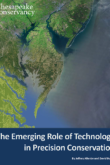
The Emerging Role of Technology in Precision Conservation
The Chesapeake Conservancy recently completed a report, funded by the Digital Energy and Sustainability Solutions Campaign, which explores the role that information and communications technology can play in guiding conservation efforts throughout the Chesapeake Bay watershed and prioritizing the protection and restoration of the region’s most valuable ecosystems. The report, entitled “The Emerging Role of Technology in Precision Conservation,” highlights new cost-effective technologies that can rapidly and accurately determine high-functioning natural landscapes that have the greatest potential for maintaining or improving the water quality of the Chesapeake Bay.
Strategic Conservation Planning will help you visualize a future for your community and chart a course to realize that vision. Because your actions today will determine the parks, working farms, forests and scenic landscapes your children and grandchildren will enjoy, it pays to be careful in how you use your resources to ensure you save the right land. Strategic Conservation Planning provides you with the process and tools to identify, prioritize, pursue and protect the land that will most effectively and efficiently achieve your conservation mission.
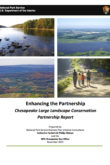
Enhancing the Partnership: Chesapeake Large Landscape Conservation Partnership Report
November 2013
Authors: Catherine Herbert, Phillip Olaleye, and the NPS Chesapeake Bay Office
DetailsThis report was developed to explore options for strengthening the Chesapeake Large Landscape Conservation Partnership (subsequently renamed the Chesapeake Conservation Partnership). Released in 2013, this report analyzes the progress of the Partnership, and offers a set of researched options and recommendations for moving the collaborative forward. Importantly, these options and recommendations are based on a detailed exploration of 14 existing models of collaborative landscape conservation initiatives from across the country. Out of the exploration of these existing models of landscape conservation emerge a set of 25 best practices for landscape conservation partnerships, with the best practices classified and organized under the following categories: Partnership Building; Institutional Framework; Financial Management; Implementation of Shared Activities; and External Communications. As such, this report is broadly relevant and applicable to landscape conservation practitioners working on initiatives and in landscapes across geographical contexts.
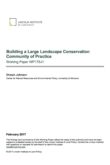
Building a Large Landscape Conservation Community of Practice: A Lincoln Institute of Land Policy Working Paper
Over the past seven years—starting with the first policy dialogue at the Lincoln House in 2009— a Joint Program between the Lincoln Institute of Land Policy and the Center for Natural Resources & Environmental Policy at the University of Montana has played a leading role in exploring and advancing large landscape conservation as an important framework for addressing some of the most critical land and water issues facing people and nature. This working paper summarizes key elements of this work, including: (1) insights gained through policy discussions, surveys, and publications, (2) creation of a network of large landscape conservation practitioners to build and share knowledge on large landscape conservation (currently transitioning in name from the “Practitioners’ Network for Large Landscape Conservation” to the “Network for Landscape Conservation”); and (3) efforts to collect and share information and tools developed by partners and others in support of large landscape conservation.

Wildlife Connectivity: Fundamentals for Conservation Action
Published by the Center for Large Landscape Conservation, this report is a primer for practitioners working to advance wildlife corridor and ecological connectivity conservation. This report is intended to provide a high-level summary of the fundamentals of wildlife corridors and ecological connectivity to people engaged in management and conservation actions. We clarify the terms used to describe connectivity and provide tangible examples of different kinds of corridors and linkages and how they work. We describe the many different ways to identify places on the landscape for connectivity and wildlife corridors, including a wide range of methods, tools, and models. Finally, because policy is critical to support conservation efforts and ensure their longevity, we provide examples of existing policies that support wildlife corridors and connectivity and how they can be replicated or expanded to other jurisdictions.
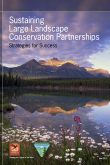
Sustaining Large Landscape Conservation Partnerships: Strategies for Success
In 2010, the Bureau of Land Management and the Sonoran Institute convened a workshop to examine trends in collaboration and community-based land management planning. This booklet shares the hard-won experience of the workshop participants, and other stories from the field, and highlights key principles for developing and sustaining landscape-scale collaborative efforts. Whether you are just starting out or have a more developed partnership, we hope that these principles and stories are helpful to you as a practitioner of large landscape conservation partnerships.
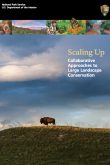
Scaling Up: Collaborative Approaches to Large Landscape Conservation
A collection of brief stories from the National Park Service that demonstrates NPS’s efforts across a wide variety of parks, programs, and initiatives that advance collaborative conservation on a landscape scale.

Regional Planning for a Sustainable America: How Creative Programs are Creating Prosperity and Saving the Environment
Regional Planning for a Sustainable America is the first book to represent the great variety of today’s effective regional planning programs, analyzing dozens of regional initiatives across North America.
The American landscape is being transformed by poorly designed, sprawling development. This sprawl–and its wasteful resource use, traffic, and pollution–does not respect arbitrary political boundaries like city limits and state borders. Yet for most of the nation, the patterns of development and conservation are shaped by fragmented, parochial local governments and property developers focused on short-term economic gain. Regional planning provides a solution, a means to manage human impacts on a large geographic scale that better matches the natural and economic forces at work. By bringing together the expertise of forty-two practitioners and academics, this book provides a practical guide to the key strategies that regional planners are using to achieve truly sustainable growth.
It takes a network to tackle growth and complexity
In an October 2016 article in the Stanford Social Innovation Review, the authors highlight social network analysis as an analytic tool to measure social interactions and relationships, and to visualize the nature, distribution, and structure of connections between individuals and organizations. The work highlighted in the article is centered on regional conservation efforts in the Texas Hill Country.

Assessing the State of Landscape Conservation Initiatives in North America: A Survey and Report
In 2017, the Network for Landscape Conservation conducted an in-depth survey of North American landscape conservation initiatives to develop a baseline of data on the practice across geographies. The survey was developed to understand the prevalence of landscape conservation efforts, and to understand trends in initiative structure and governance, focus and/or emphasis, strategies and actions, performance and evaluation, and the extent of dialogue and exchange across initiatives. This summary report synthesizes the data collected from 130 responding landscape conservation initiatives to bring into focus the current development of the landscape conservation field.

Large Landscape Conservation in the Rocky Mountain West
This inventory and status report explores the emergence of landscape conservation initiatives in the Rocky Mountain West. The report clarifies who is doing what with respect to landscape conservation in the region, and draws insights out of an analysis of the inventory data. The report is intended to promote, support, and advance landscape conservation throughout the Rocky Mountain West.
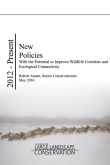
New Policies with the Potential to Improve Wildlife Corridors and Ecological Connectivity
This report is a compilation of federal and state policies that have direct or indirect implications for wildlife corridors and ecological connectivity conservation. It is a continuation of new federal policies that were first reported in 2012, The Obama Administration’s Progress on Federal Policies for Wildlife Corridors and Ecological Connectivity Conservation: January 2009 through December 2012 (online at: http://largelandscapes.org/media/publications/Obama-Admin–Progress-on-Federal-Policies-for-Wildlife- Corridors2.pdf). This report provides a broad set of policy-setting activities, such as legislation, executive orders, secretarial orders, strategies, and memoranda, by the executive or legislative branches of state or federal governments.

Landscapes: Improving Conservation Practice in the Northeast Megaregion
Buying land isn’t enough. Building parks won’t get it done. Restoring forests and wetlands by themselves is not an answer. Successful conservation requires a compre- hensive, regional approach.
Landscape conservation means looking beyond property boundaries and political jurisdictions. A holistic perspective is vital
for managing watersheds and habitats and addressing long-term issues such as climate change. With funding scarce, it’s also crucial to build partnerships that can set mutual priorities, share resources and collaborate e ectively. As the population grows and development expands, conservation needs to help shape – and not simply react to – deci- sions about land use and urban infrastructure.
is is especially true for complex geogra- phies like the 13-state Northeast megaregion. is densely developed area – stretching from Maine to West Virginia – is now home to about 72 million people. Its cities, suburbs and rural areas are expected to add an addi- tional 15 million people by the year 2040. Where these people are housed, and how their transportation and energy needs are met, will dictate whether the region’s wildlife, drinking water and other resources, farms and forests, and outdoor recreational opportuni- ties are truly lasting.
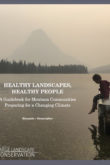
Healthy Landscapes, Healthy People: A Guidebook for Montana Communities Preparing for a Changing Climate.
This guidebook was prepared for the 2018 Montana Faith, Science, and Climate Action conference, and is intended to serve as a guide for people who are concerned about human health and climate change. The guide is framed through a landscape perspective, focusing attention on why landscapes are important and how they relate to human health. Through grounded in a specific geographical context, the framing perspective of protecting landscapes is relevant and applicable across all contexts, and the recommendations around planning and communicating about the intersection of landscape, human health, and climate change likewise are broadly relevant.
A Rural Voices for Conservation Coalition issue paper explores the emerging notion of an “all lands, all hands” collaborative approach to natural resources management in the rural west.
All Lands Management: The Role of Policy, Practice and Peer Learning
This issue paper presented by the Rural Voices for Conservation Coalition highlights the importance of working across public and private boundaries for addressing the ecological and economic challenges facing the rural West.
Protecting Nature: Landscape Scale Conservation in the United States
In this webinar, Peter Howell discusses his work at the Open Space Institute, a conservation organization that focuses on landscape scale conservation throughout the Eastern United States. Through recent projects spearheaded by OSI, Howell illustrates the challenges and opportunities that landscape-scale conservation presents, and shares his insight on current trends regarding conservation in the United States.
Presented as part of the Yale Center for Business and the Environment “Nature’s Returns: Investing in Ecosystem Services” webinar series.
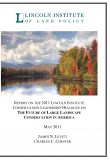
Report on the Conservation Leadership Dialogue on the Future of Large Landscape Conservation in America
This report on the 2011 Conservation Leadership Dialogue on The Future of Large Landscape Conservation in America was produced based on a one-day meeting of invited guests at the Members of Congress Room in the Jefferson Building of the Library of Congress in Washington, DC. The event was a program of the Lincoln Institute of Land Policy, based in Cambridge, Massachusetts, USA, and partner organizations, including the Center for Natural Resource and Environmental Policy at the University of Montana, based in Missoula, Montana; the Regional Plan Association, based in New York, New York, and the Sonoran Institute, based in Tucson, Arizona.
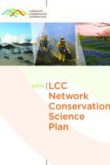
LCC Network Conservation Science Plan
The LCC Network Conservation Science Plan (Science Plan) advances a strategic conservation framework to identify and describe the common science and technical priorities and practices that transcend individual LCC geographies and support the LCC Network’s vision and mission. The intent of this document is to add value to individual efforts, while also providing mechanisms for aligning such efforts across multiple spatial scales. While the document is framed by and written for Landscape Conservation Cooperatives, many of its principles and insights are widely applicable across all landscape conservation initiatives.
A web-based decision support guide managed by Conservation Corridor. Are you looking for a tool or program to help you design, implement, and/or manage corridors and connectivity in the landscape? Our Connectivity Tool Decision Guide is aimed at guiding you towards the most appropriate tool to use for your specific project.
It is often the case that multiple tools are needed to more accurately address your questions, so it may be beneficial to work through the Decision Guide more than once. Keep in mind that this is meant to be only a suggestion, and finding the most appropriate tool(s) to use is often determined by multiple factors that may be outside the scope of these questions.
Across the country, dozens of state and local governments each year vote to raise public funds in support of land conservation. The Trust For Public Land’s LandVote® Database is the premier source of information about these measures. The database brings together the most comprehensive history available for conservation finance measures that have been placed on the ballot.
The Language of Conservation: Updated Recommendations on How to Communicate Effectively to Build Support for Conservation
The “Language of Conservation” is a memo that contains recommendations for communicating effectively to build support for conservation, and is based on a representative national survey of American voters commissioned by The Nature Conservancy in 2012 and conducted by a bi-partisan research team: Democratic polling firm Fairbank, Maslin, Maullin, Metz & Associates and Republican polling firm Public Opinion Strategies. This memo seeks to provide language and messaging recommendations in a list of easy-to-follow, broad “rules” for communication. Some of these rules reinforce long-standing communication guidelines that have been tracked over time, while others were tested to reflect today’s changed political and economic context.
A web-based resource maintained by Conservation Corridor, this toolbox contains a catalogue of nearly 20 programs and tools for designing and working with corridors, a database of technical and peer-reviewed literature, and links to additional web-based resources.
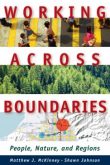
Working Across Boundaries: People, Nature, and Regions
This book is a explores the process of working across boundaries on land use and natural resources issues. The emphasis is practical: the book serves as a guide, presents a variety of principles, techniques, strategies, and concepts to help people diagnose regional problems, design an appropriate regional forum, develop and implement regional action plans, and evaluate and adapt their regional initiatives. As such, it has become a valuable resource for citizens, practitioners, and policy makers grappling with transboundary challenges who seek guidance on the process by which regional solutions can be identified and implemented.
Potential Conservation Easement Provisions Designed to Explicitly Address Connectivity in the Northern Appalachians
This publications puts forward sample conservation easement language designed to explicitly address issues of habitat connectivity. These provisions are intended to facilitate the drafting of connectivity language appropriate to the particular circumstances of a specific conservation easement property.
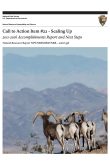
Call to Action Item #22 – Scaling Up: 2011-2016 Accomplishments Report and Next Steps
Call to Action Item 22 “Scaling Up,” called the NPS to “Promote large landscape conservation to support healthy ecosystems and cultural resources.” This report documents accomplishments for the 5 year period from 2011 to 2016, and lays out next steps.
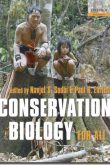
Conservation Biology for All
This book contains a series of authoritative chapters written by top names in conservation biology with the aim of disseminating cutting-edge conservation knowledge as widely as possible. Important topics such as balancing conversion and human needs, climate change, conservation planning, designing and analyzing conservation research, ecosystem services, endangered species management, extinctions, fire, habitat loss, and invasive species are covered. Numerous textboxes describing additional relevant material or case studies are also included.
The National Conservation Easement Database (NCED) is the first national database of conservation easement information, compiling records from land trusts and public agencies throughout the United States. This effort helps agencies, land trusts, and other organizations plan more strategically, identify opportunities for collaboration, advance public accountability, and raise the profile of what’s happening on-the-ground in the name of conservation.
Landscape-Scale Conservation: Grappling with the Green Matrix
This article is a summary of the 2003 Conservation Leadership Dialogue hosted by the Lincoln Institute for Land Policy and partners. The purposes of the two-day conference were: to advance our emerging understanding of what, in concept, landscape-scale initiatives are, and why they may be necessary; to better understand how such concepts are (or are not) being realized in the field; and to identify which innovations and advances appear necessary to more fully realize such large and comprehensive initiatives.
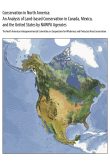
Conservation in North America: An Analysis of Land-based Conservation in Canada, Mexico, and the United States by NAWPA Agencies
2016
The North American Intergovernmental Committee on Cooperation for Wilderness and Protected Area Conservation
Details
Conservation Practice at the Landscape Scale
This thematic issue of the George Wright Forum explores the complexity, multiple benefits, and urgent challenges of landscape-scale conservation, while also identifying a wide range of elements that contribute to success. The issue describes a number of large-scale conservation initiatives. Five case studies are included, ranging from cross-international boundary work in the northern Appalachians and the Rockies to the conservation efforts of the regional watershed of the Potomac; and from the cultural heritage of America’s distinctive regional landscapes to the biodiversity of the Brazilian Atlantic forest.
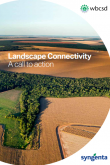
Landscape Connectivity: A Call to Action
Creating landscapes with healthy, functioning ecosystems is not only key to making progress towards the environmental targets embedded in the Sustainable Development Goals, but also to addressing multiple social and economic targets that depend partly or wholly on the bene ts that ecosystems provide to people.
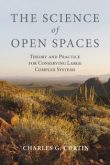
The Science of Open Spaces: Theory and Practice for Conserving Large Complex Systems
From the days of the American Frontier, the term “open spaces” has evoked a vision of unspoiled landscapes stretching endlessly toward the horizon, of nature operating on its own terms without significant human interference. Ever since, government agencies, academia, and conservation organizations have promoted policies that treat large, complex systems with a one-size-fits-all mentality that fails to account for equally complex social dimensions of humans on the landscape. This is wrong, argues landscape ecologist and researcher Charles Curtin. We need a science-based approach that tells us how to think about our large landscapes and open spaces at temporally and spatially appropriate scales in a way that allows local landowners and other stakeholders a say in their futures.
The Science of Open Spaces turns conventional conservation paradigms on their heads, proposing that in thinking about complex natural systems, whether the arid spaces of the southwestern United States or open seas shared by multiple nations, we must go back to “first principles”–those fundamental physical laws of the universe–and build innovative conservation from the ground up based on theory and backed up by practical experience. Curtin walks us through such foundational science concepts as thermodynamics, ecology, sociology, and resilience theory, applying them to real-world examples from years he has spent designing large-scale, place-based collaborative research programs in the United States and around the world.
Compelling for not only theorists and students, but also practitioners, agency personnel, and lay readers, this book offers a thoughtful and radical departure from business-as-usual management of Earth’s dwindling wide-open spaces.

America’s Working Lands: Farm Bill Programs and Landscape-scale Conservation
Affirming the substantial national conservation and ecosystem benefits associated with farmlands, ranchlands, and forests, every Farm Bill since 1985 has included a section dedicated to conservation programs. During each five-year reauthorization cycle, the Farm Bill conservation provisions undergo scrutiny regarding funding, structure, goals, program effectiveness, and geographic emphasis.
This White Paper examines Farm Bill conservation programs through a large landscape conservation lens and addresses four questions: (1) how does current implementation of Farm Bill conservation programs support landscape-scale conservation? (2) what Farm Bill conservation tools are particularly useful in supporting landscape-scale conservation? (3) what challenges or barriers limit the potential of Farm Bill conservation programs to support landscape-scale conservation?; and (4) what Farm Bill conservation program administrative and legislative measures might enhance large-landscape conservation?


